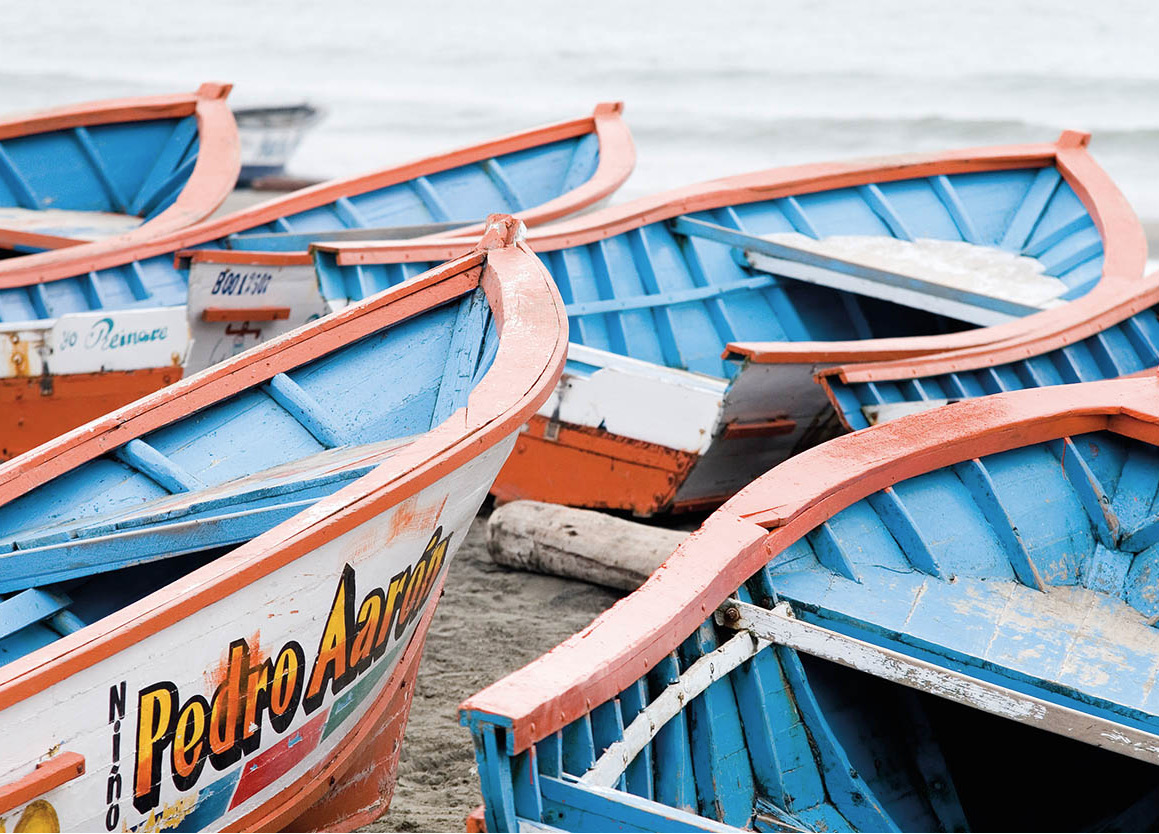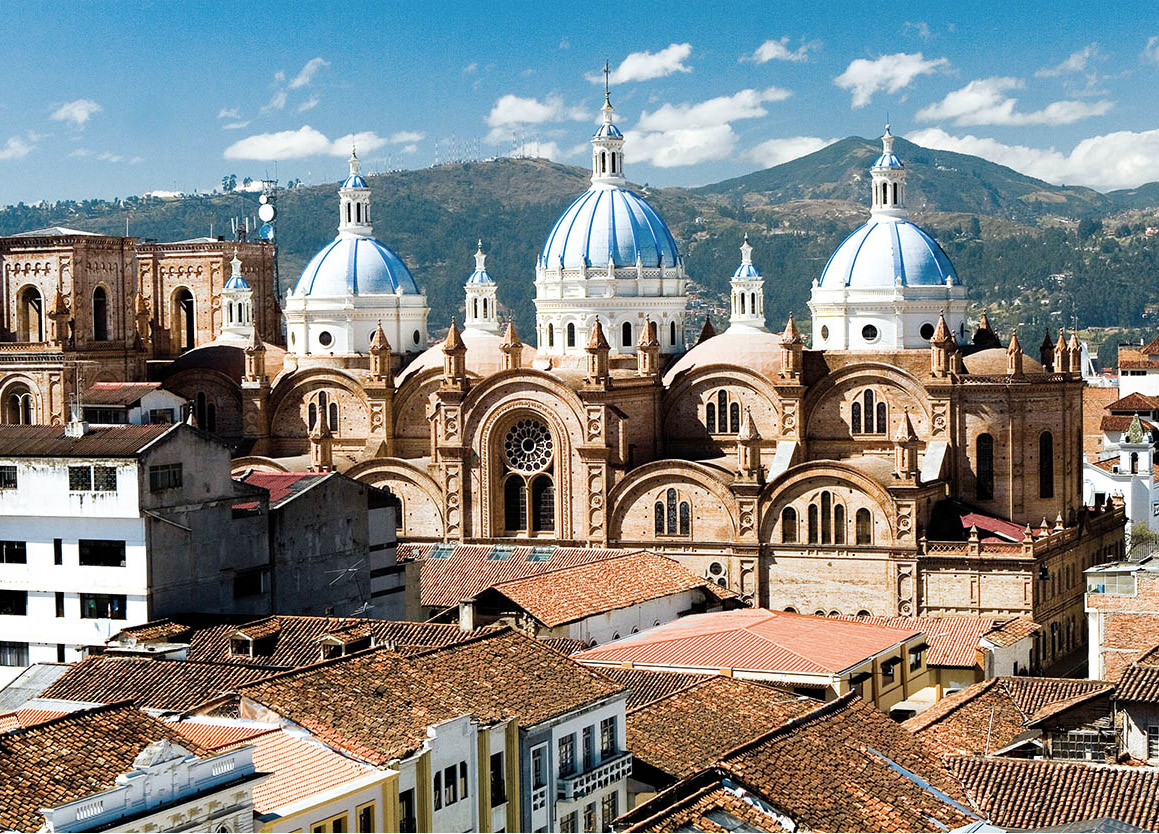There is no single Ecuadorian cuisine, but several ones that correspond to Ecuador’s geographical regions: Costa, Sierra, and Oriente. And what you will find in good restaurants is quite different from what most people eat in rural areas and what you will find in market booths and small cafés throughout the country.
Bananas, however, are everywhere. Several varieties are grown on the coast and in the Oriente, from tiny finger bananas (oritas) to large, green cooking plantains (plátanos or verdes). The yellow bananas of the kind Westerners are accustomed to are called guineos in Ecuador. Short, fat red bananas called maqueños are also good to eat raw. Bananas and plantains are trucked up to every highland town and market, so you’ll have no trouble finding them.
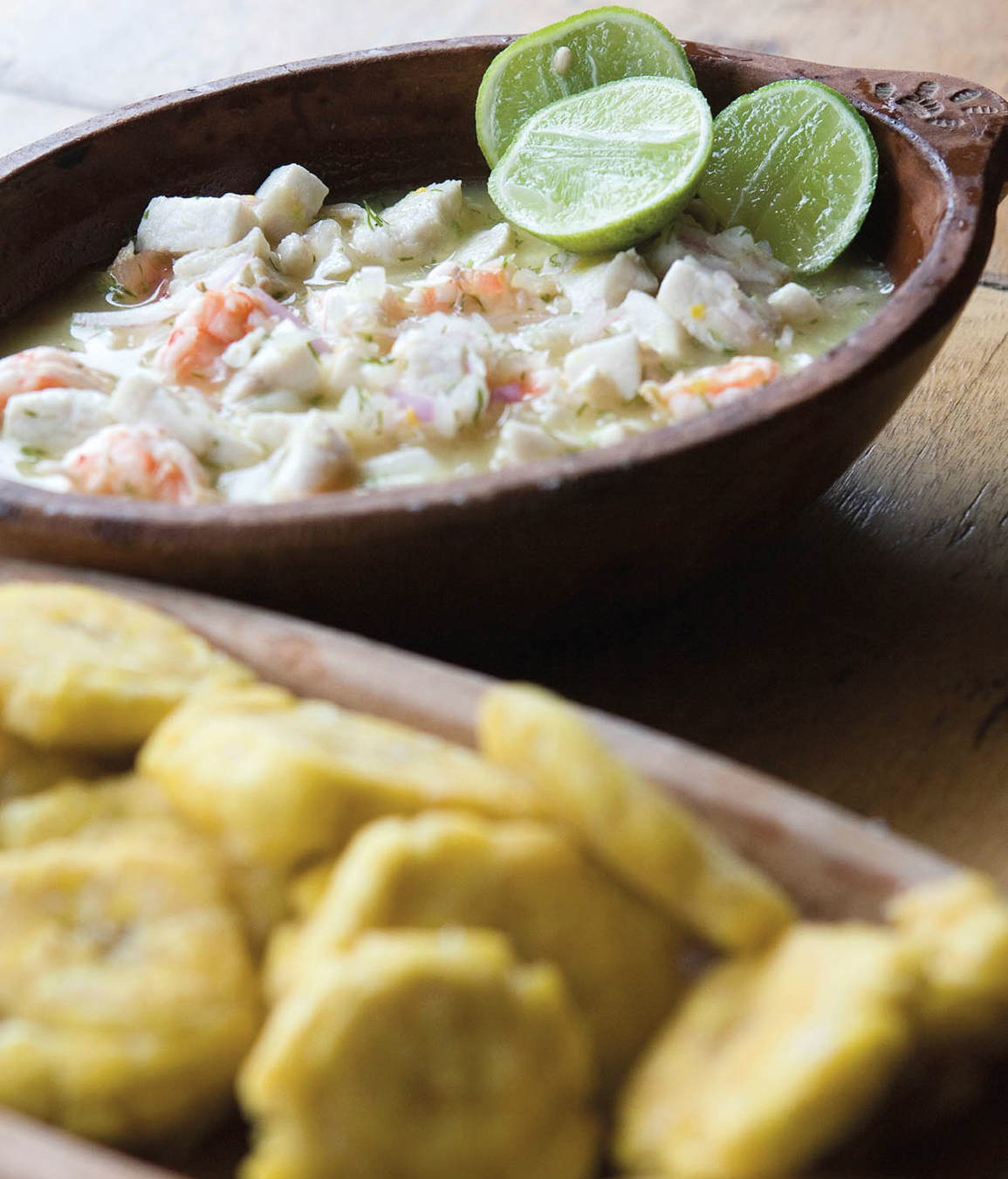
Ceviche can be made from a variety of seafood.
Corrie Wingate/Apa Publications
Staple foods
Rice (arroz) is not an indigenous food, but it is ubiquitous, although potatoes (papas) are more of a highland staple. You can count on one or the other to come with every meal. And sometimes, for a complete carbohydrate overload, noodles (fideos), potatoes, rice, yuca (a white starchy tuber), and plátanos will be served, and that’s the meal. This is poor people’s food, and a partial explanation of why many Ecuadorians are short in stature: besides a genetic component, they do not consume much protein.
Ecuador was the original banana republic. For many years bananas were its principal export, and the country is still among the world’s largest exporters.
Ecuador is overflowing with fruit, from enormous papayas to more exotic treats like passion fruit (ayatacso, maracuyá, and granadilla are just a few varieties), sweet custard apples (chirimoyas) and tart tamarinds (tamarindos). The naranjilla, a tiny fruit that looks like a fuzzy, orangey-greenish crab apple, makes a strange-colored but tasty drink that is often served instead of orange juice. If you are uncertain about how to eat a fruit, try it as a juice (jugo). You can ask for juice without water (sin agua) and without sugar (sin azúcar).
Visit a market as soon as possible after your arrival. Do not be intimidated by the strange-looking array. Instead, buy every fruit you’ve never seen before, then go back to your hotel or hostal and ask the owner to share them with you and tell you the names of the different varieties. You’ll discover some delicious fruits, which you can then enjoy for the rest of your trip.
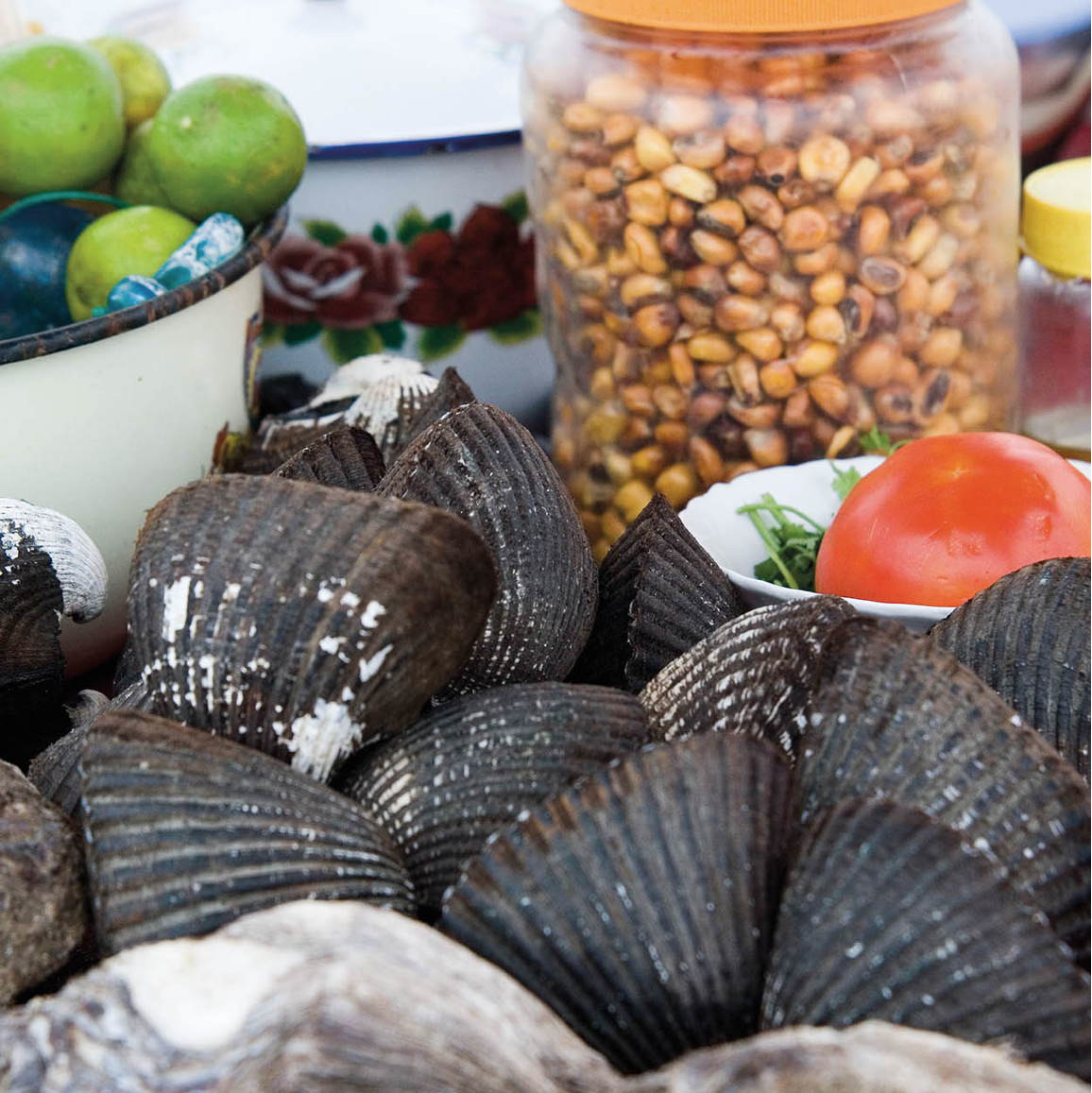
Some of the ingredients for making ceviche.
Corrie Wingate/Apa Publications
Pacific flavors
Many of the coastal dishes are typical of the entire Pacific coast from Chile to Mexico. They include ceviche, which is fish (pescados) or various types of seafood (mariscos) marinated in lemon or lime juice, onions, and chili peppers. The dish has been around since Inca times, when they marinated raw fish in chicha. Ecuadorian ceviche is quite soupy, uses oil and tomatoes, and is served with popcorn on the side.
Ecuador’s superb sea bass is served a number of ways, including fried (frito), breaded and fried (apanado), and filleted and grilled (a la plancha). Try any seafood cooked in agua de coco (coconut milk), including clams (almejas or conchas), grouper (cherna), mackerel (sierra), marlin (picudo), snapper (pargo), tuna (atún), and squid (calamares). The dorado, or dolphinfish, which is not a mammal like the true dolphin, is also popular and not to be missed.
A thoughtful Ecuadorian custom for regulating the spiciness of food is to serve hot sauce (salsa picante) made from chili peppers (ají) in a little side dish so that you can add as much or as little as you like.
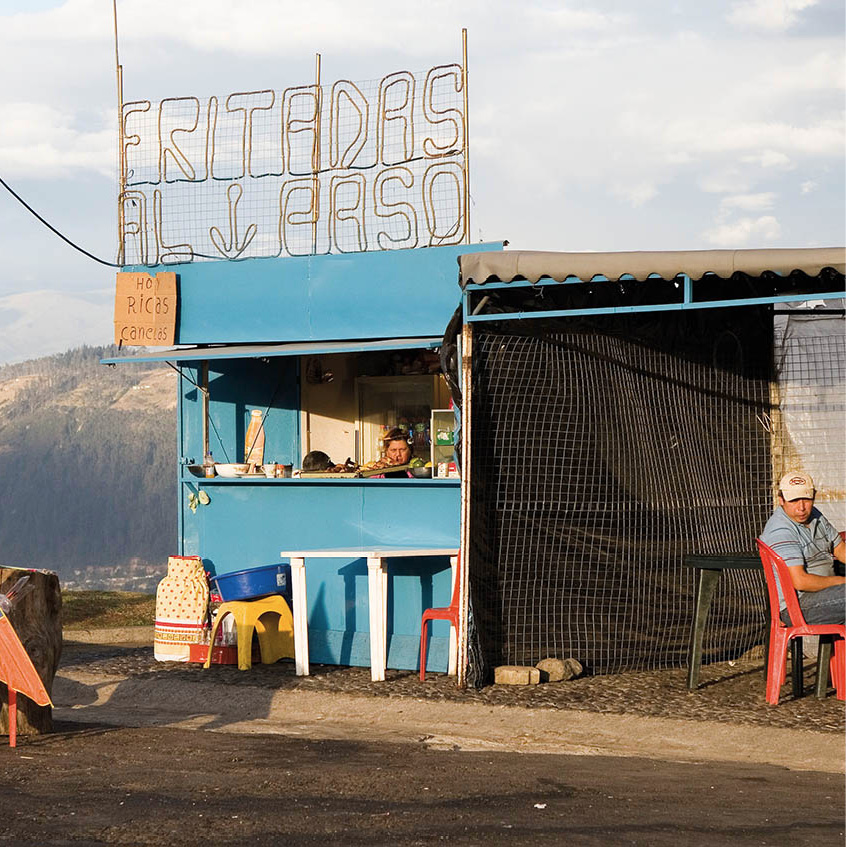
A roadside food stall in Quito’s Old Town.
Corrie Wingate/Apa Publications
Tastes of the Oriente
Coastal and Oriente foods are similar because of the two regions’ low elevation and tropical climate, although there is more game-hunting in the jungle (everything from monkeys to tapir and paca, a large rodent) and freshwater fish instead of seafood. In both places you’ll find lots of plátanos, yuca, rice, and fried fish. There are several dishes served exclusively in the Oriente, however. One is piranha, although it surprises many visitors that the notorious carnivorous fish is itself good for eating. The Oriente rivers also have lots of catfish (challua or bagre), which people make into a stew with plantains, chili peppers, and cilantro (leaf coriander).
For a jungle salad, try palmitos (palm hearts) or chonta palm fruits (frutas de chonta), both considered delicacies. Chucula is a tasty drink made with boiled and mashed plantains, which resembles a banana milkshake.
Andean festival dishes
Andean festivals are a great place to try local foods. Fanesca is an incredibly rich soup served only during Holy Week (the week before Easter). You name it and fanesca has it: fish, eggs (huevos), cheese (queso), corn, and every imaginable grain and vegetable, but no meat. Cuy, or guinea pig, is often eaten on special occasions, and you can almost always find it in some form during Andean festivals. Whether it’s fried, roasted with potatoes, or in a spicy sauce, cuy is a delicacy. Yahuarlocro is a hearty potato soup made with sheep’s innards seasoned with oregano and peanuts and served with avocado, chopped red onion, and tomato.
Serrano cuisine
As we climb to the highlands, a word about the tuber, that traditional mainstay of indigenous Andean life. There are a lot of tubers in the Andes, beginning with dozens of varieties of potatoes. The potato was cultivated around Lake Titicaca, the region that still has the most varieties, some of which are so specialized they grow only at altitudes above 2,400 meters (8,000ft). Potatoes are served with almost every meal in the highlands, usually boiled, but sometimes cut up and added to thick soups. If you don’t like potatoes you’re in trouble in Ecuador. They are the food of the common people, and, as in Inca times, everyone plants and eats them. The great Inca terraces, however, used to be reserved for another crop, corn, which was usually made into chicha.
Besides regular white potatoes in many sizes and varieties, you will come across the sweet potato (camote) as well as the oca, which looks like a long, skinny, lumpy potato. One Ecuadorian potato specialty is llapingachos, potato pancakes made with potatoes, cheese, and onions and eaten with fried eggs and spicy sausage. A better lunch cannot be had.
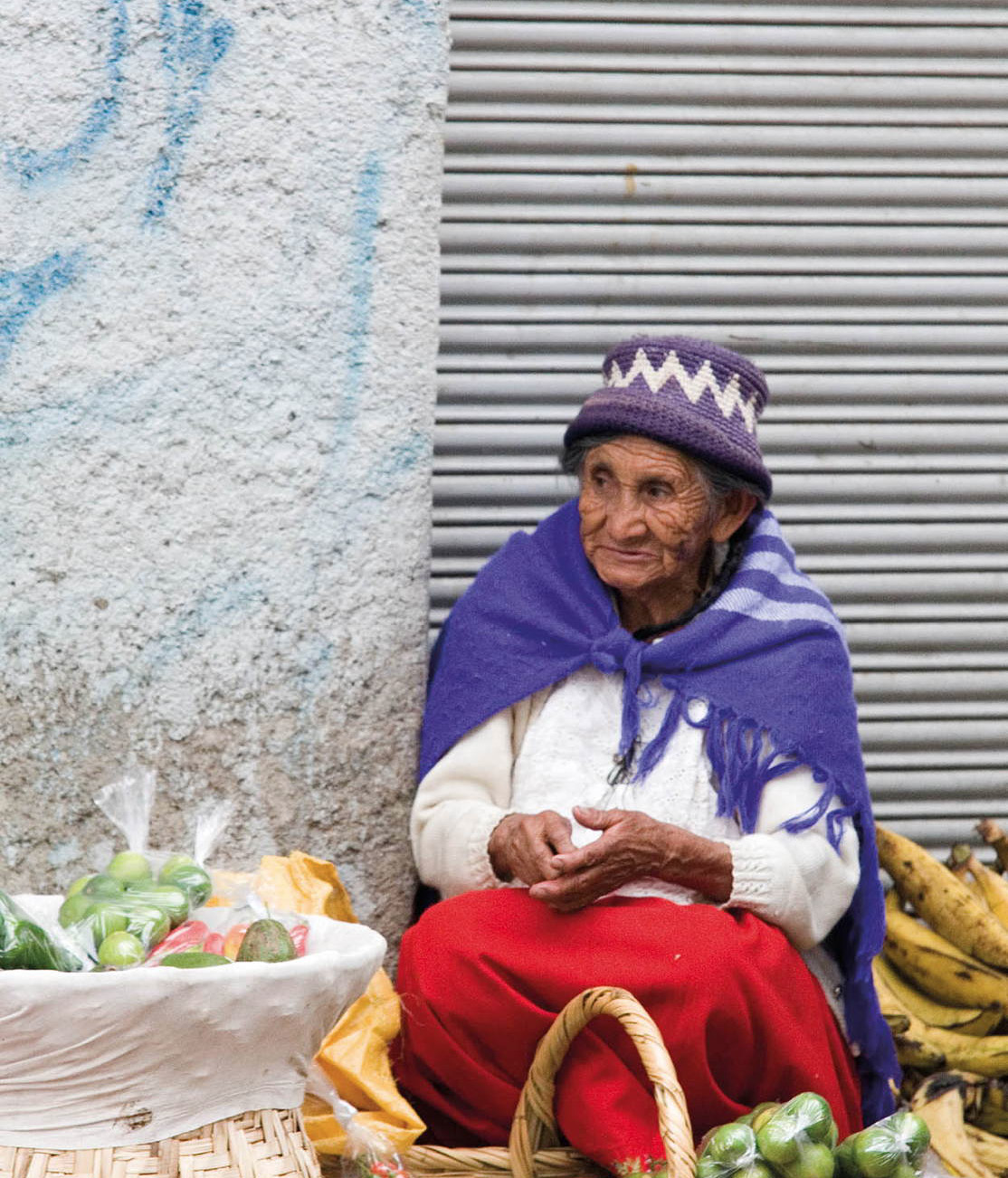
Chilis and limes for sale in Cuenca.
Corrie Wingate/Apa Publications
Soups are the essence of meals in the Sierra. Before the Spanish conquest indígenas did not have ovens for baking, which meant that most food was boiled, a custom that survives today. Soup is called caldo, sopa, chupe, or locra. Generally, a sopa or a caldo is a thin soup with potatoes and various unidentified floating objects of the faunal variety. A locro or chupe is a thick, creamy soup. Sopa seca or just plain seco (which means dry) is more of a stew than a soup, with meat and vegetables added according to the budget and whim of the cook. One of the most common locros is called yaguar locro (blood soup) that contains the heart, liver, and other internal organs (which is to say tripe, or mondongo) of a cow (vaca or res), pig (chancho), or sheep (borrego); the soup is sprinkled with blood sausage or the animal’s dried blood.
Mazamorra is a thick soup made with a ground corn base and cabbage, potatoes, onions, and spices. Sancocho is a stew made with plátanos and corn. Most soups and stews are liberally seasoned with cilantro and many are given a yellow or orange color by the -addition of achiote seeds.
Corn (maíz or sara) is another staple, especially in the Sierra. Unlike in Mexico and Central America, corn in the Andes is not ground and made into tortillas. In northern Ecuador corn is most commonly served on the cob (choclo). Ecuadorian corn has enormous, sweet kernels arranged irregularly, and it’s the best corn-on-the-cob imaginable. In the north, corn is also eaten as parched kernels (kamcha) or as popcorn (canguil). In southern Ecuador it is commonly served as boiled kernels (muti or mote). Humitas are corn tamales: cornmeal seasoned and steamed in the leaf. Don’t eat the leaf – unwrap it and eat what’s inside. Tostadas de maíz are corn pancakes that make a good breakfast or snack.
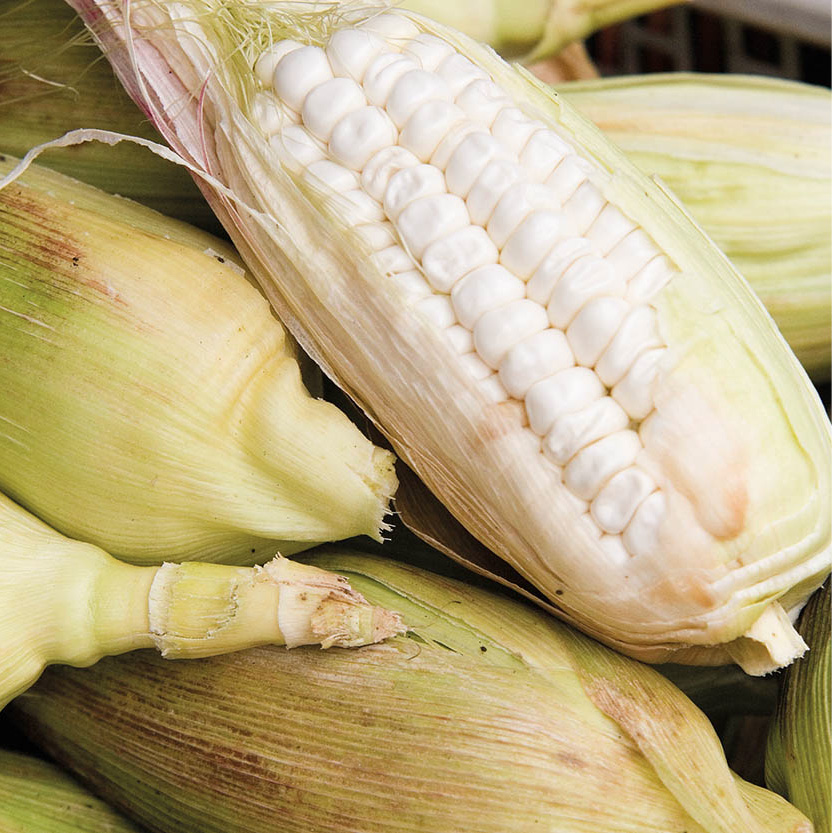
Corn is one of Ecuador’s staple foods.
Corrie Wingate/Apa Publications
Miracle grain
Other grains grown locally include quinoa, wheat (trigo), and barley (cebada). Quinoa is native to the Andes. This tiny, round grain is an amazingly nutritious food, consisting of 15 percent complete protein, 55 percent carbohydrate, and only 4 percent fat. The Incas regarded quinoa as sacred, and it was their second-most important food crop. Quinoa is usually served in soup, but it can also be eaten as a side dish, in the same way as rice. The grain has become a staple in Novo Andina, New Andean food which blends traditional Andean recipes with contemporary cooking methods. Quinoa is often served as a risotto or used to encrust a fish or meat.
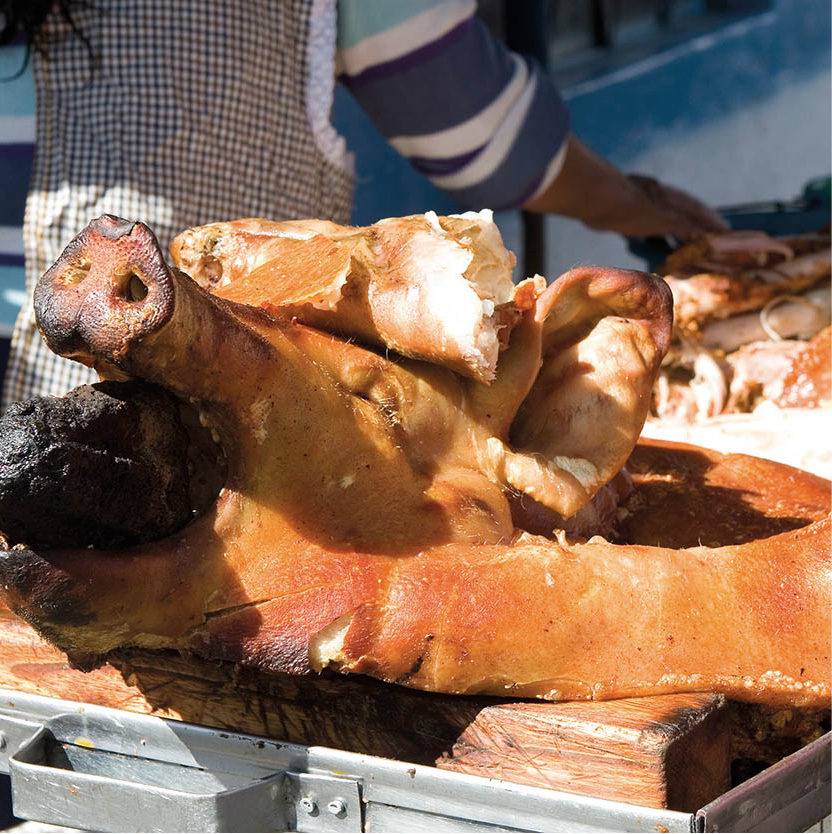
Spit-roast pig is popular street food in Ecuador.
Corrie Wingate/Apa Publications
Most barley is ground up and used in soup, but wheat flour is used to make a variety of good breads and rolls (pan and panecitos) and empanadas, which are baked pastries filled with cheese or meat. Around Latacunga you’ll hear women at street stalls calling allullas, allullas (pronounced “azhúzhas”). These are homemade rolls, good when hot and fresh, but hard when they get cold.
Broad beans are called habas. These beans, which are much larger than you may have seen at home, are boiled and served hot, dipped in salty campo cheese, or cold in a salad dressed with butter and lemon juice.
From pet to pot
If you’ll settle for something smaller than a sirloin, try guinea pig (cuy). Until the arrival of the Europeans, cuy was the main source of meat in the Andes. Every family had guinea pigs running around the kitchen, and some still do.
Cuy is eaten only on special occasions, when one is scooped up, killed, gutted, cleaned, rubbed with lard and spices, put on a spit, and roasted in the fire or baked in the oven. If you can bring yourself to try cuy, you will find that there’s not much meat, but what there is is delicious, and, as the Ecuadorians put it, what else are guinea pigs good for?
Meat dishes
You should ask for lomo or bifstec, or chuleta if you want a chop. Parrilladas are steakhouses or grills, where the meat is sometimes charcoal-grilled at your table. A la parrilla means grilled, and churrasco or lomo montado is meat (usually beef) topped with fried eggs. You can also order veal (ternera), lamb (cordero), or pork (puerco or chanco; kuchi in Quichua). Lechón is suckling pig. Salchicha means sausage, while chorizo refers to pork sausage. Bacon is called tocino, ham is jamón.
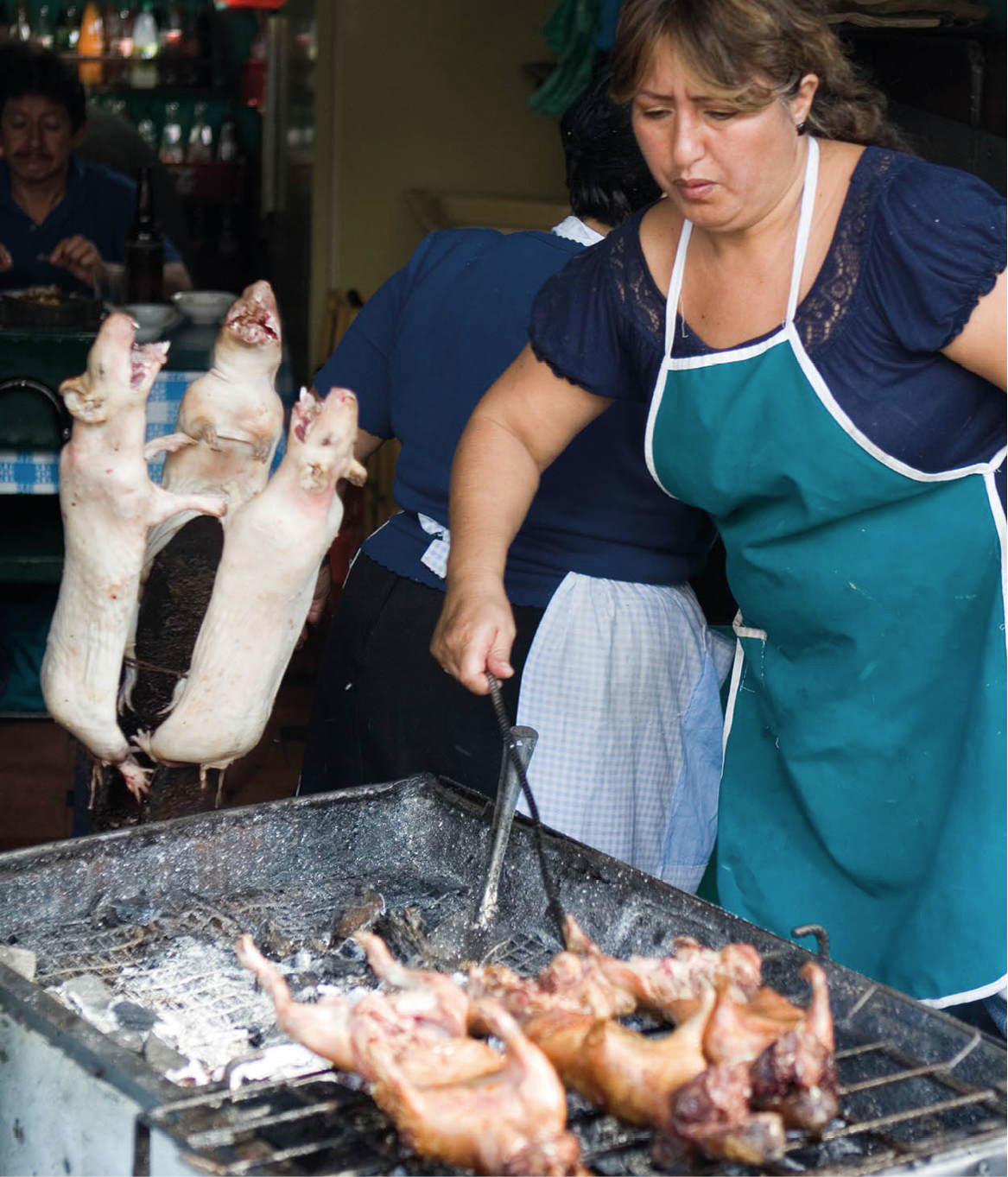
Cooking cuy (guinea pig) in Baños.
Corrie Wingate/Apa Publications
Asado, which means roasted, always refers to whole roasted pig in Ecuador, unless otherwise modified. Fritada (fried pork) is cooked in large copper and brass pailas (wok-like pans) and chicharrón is fried pork skin, crispy and delicious.
The Quichua language has contributed one word to English: “jerky,” derived from charqui, meaning dried meat. Made from any form of meat, it is normally sun-dried and often “rehydrated” for use in empanadas.
Other sources of dietary protein include chicken (pollo) or hen (gallina), and eggs served in the usual ways, as well as pasteurized cow’s milk (leche), which is sold in unwieldy liter-sized plastic bags, and excellent cheese (queso), the quality of which has soared in recent years with the arrival of Swiss and Italian immigrants who have introduced European varieties. As for fish, in the Sierra many streams and lakes have been stocked with tasty, if rather bony, trout (trucha).
Sweet success
Ecuador produces one of the world’s best cacaos due to its unique floral, fruity and spicy notes. Nowadays it has regained its reputation as the big name in gourmet chocolate, being the number one exporter of top-quality chocolate (defined as containing over 70 percent cacao), but for a long time, the country’s chocolate industry looked like fizzling out altogether.
To discuss cacao in Ecuador is to discuss Ecuadorian history itself. The Spaniards identified cacao trees soon after setting foot on these shores in the 16th century, and were exporting beans as early as 1630. It was initially a clandestine trade, but was booming by the late 19th century, when Ecuador led the world in the cacao business. Unfortunately, in the early 1900’s an unknown disease devastated most of the crops and plunged the country into crisis. However, in recent decades the sector has revived and today over 500,000 farmers making a living from cacao crops. Whilst heavy emphasis has been placed on exportation, chocolate’s value as a consumable product and tourism draw within Ecuador has been realized. In Guayaquil, an area producing the renowned arriba cacao, you can take a tour of cacao plantations, chocolate factories and chocolate-themed meals with Cacaoforum Tours (tel 04-227 5975).
Slaking your thirst
Bebidas is the term for beverages in general, alcoholic or otherwise. Ecuadorian wine (vino) is unlikely to win any international awards, although occasionally bottles can be quite good. Argentinian and Chilean wines are often excellent, but expensive. You’re better off sticking to soft drinks (gaseosas), mineral water (agua mineral), among which Güitig (pronounced wee-tig) is the most common brand, or beer (cerveza). There are a number of locally brewed beers, the most common of which is Pilsener.
There is also tea (té), herb tea (agua aromática), hot chocolate (chocolate caliente or cocóa), and coffee (café). This last is usually boiled until it becomes a sludge, then set on the table in a small carafe. Known as esencia (essence), it looks just like soy sauce and causes some interesting confusion in Chinese restaurants (chifas). The esencia is poured in your cup and hot water or milk is added; its taste is similar to instant coffee. Black coffee is tinto, coffee with milk is café con leche, and coffee with hot water and milk is pintado (“painted”). Api is a thick, hot drink made from ground corn; chicha morada is a sweet, non-alcoholic drink made from purple corn.

Canelazo, a mix of hot spiced orange juice and aguar-diente, for sale on La Ronda.
Corrie Wingate/Apa Publications
When it comes to liquor, what you get is the most potent intoxicant with the highest imaginable octane rating: a distilled sugarcane liquor known as trago or puntas, which burns with a clear blue flame. Local brands include Cristal and Sinchi Shungu (“strong heart”); there are several nameless varieties that are produced without sanitary regulation in the countryside. Hervidas are hot drinks served at every fiesta, consisting of trago mixed with honey and naranjilla or blackberry juice; guayusa is trago mixed with sugar and hot guayusa tea, while canelazo is trago spiced with cinnamon, sugar, and lime. As they say in Ecuador: ¡Buen provecho!
A very special specialty
One jungle specialty is c (or aswa), a fermented beer made from yuca, which is also known as manioc (mucuna). In order to make the chicha ferment, women chew the manioc, spit it into a large jar, and add water – the enzymes in the saliva cause the fermentation. In the highlands, however, chicha is not made by mastication; instead yeast and sugar are added to make it ferment.
Generally, the drink will only be offered to you in people’s homes, so if you find the thought of it unpalatable you needn’t worry about encountering chicha in the course of ordinary travel, unless your tour includes remote rainforest homes.
